#*Kallir
Photo
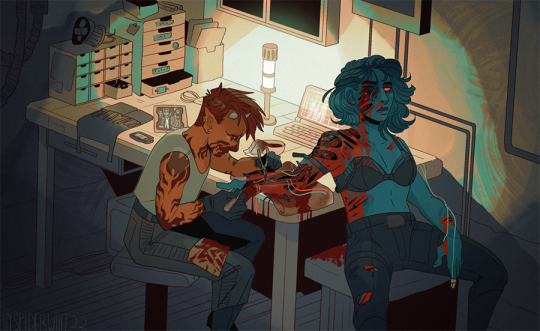


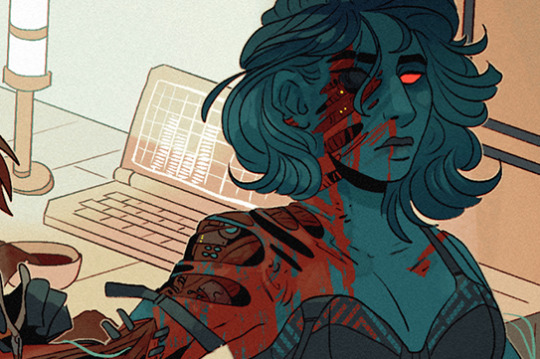
[art (incl. robot part designs) commissioned from the amazing @spindlewit ]
Sparse options of Intelligence-trained medtechs to fix a Cipher’s Intelligence-issue cybernetics this far from Dromund Kaas...
One solution for Severine (@cipherr) is to bully help from ex-Operative Kallir- Malith, hiding out on Tatooine.
#SWTOR#Zabrak#*Kallir#*Malith#Chiss#Imperial Agent#star wars cyborg#cw: blood#cw: body horror#(this is SO fantastic in high-rez btw u all have no idea)#(LOOK AT THEM THO~!!!)
226 notes
·
View notes
Text

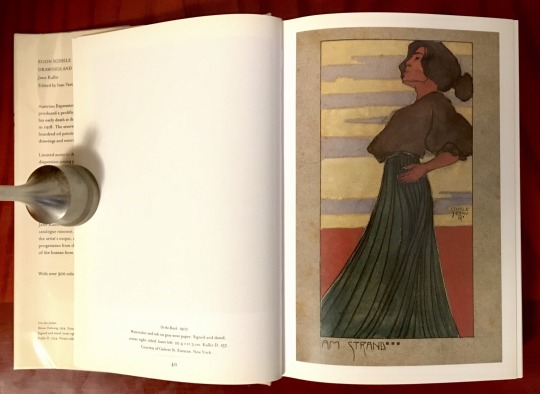

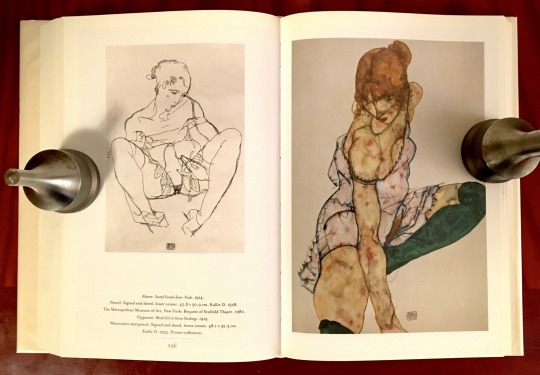

Book 196
Egon Schiele: Drawings and Watercolors
Jane Kallir / Ivan Vartanian, ed.
Thames & Hudson 2003
Beginning with the early years through 1907 and progressing year-by-year until the year of his death in 1918, this book collects Schiele’s works on paper in one beautiful volume. With over 300 color reproductions, this book allows one to trace the incredibly rapid stylistic evolution Schiele made during his brief career. Sensual, erotic, challenging, expressive, and always beautiful, this book is a brilliant and enormously satisfying examination of Schiele’s brilliance.
#bookshelf#illustrated book#library#collection#personal library#personal collection#books#book lover#bibliophile#booklr#egon schiele#Jane kallir#Ivan vartanian#Thames & Hudson#art
1 note
·
View note
Text
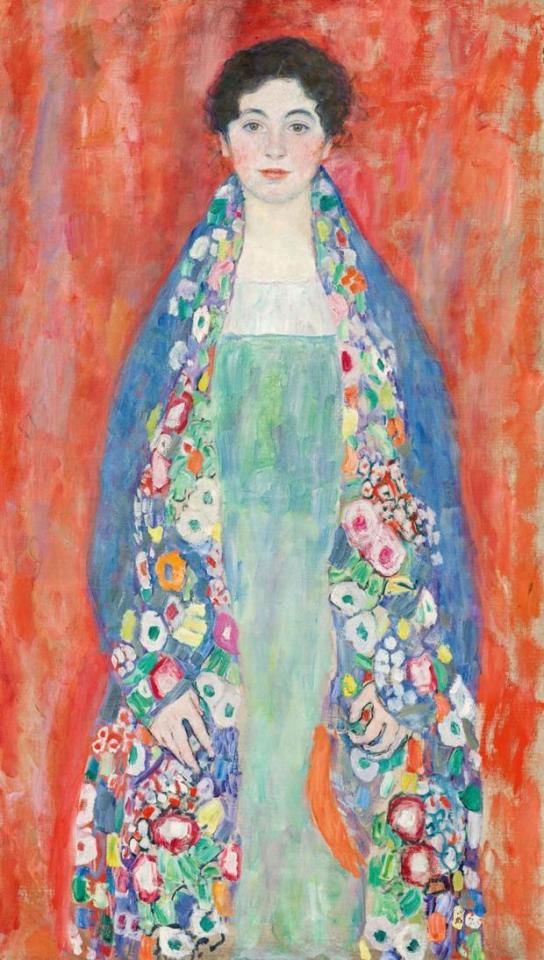
Gustav Klimt Portrait Found After Vanishing Nearly 100 Years Ago
It is one of the last works the artist painted before his death in 1918.
One of the last paintings by the renowned Austrian artist Gustav Klimt has miraculously been found after vanishing nearly 100 years ago.
The painting, titled Portrait of Fräulein Lieser, was found in Vienna after last being seen by the public in 1925. Until now, the only known photograph of the painting had been held in the archives of the Austrian National Library. The picture was likely taken in 1925 in connection with the Klimt exhibition by Otto Kallir-Nirenstein in the Neue Galerie, Vienna.
Since then, its location had been a mystery.
"The rediscovery of this portrait, one of the most beautiful of Klimt's last creative period, is a sensation," said the im Kinsky auction house in a statement announcing the discovery. "As a key figure of Viennese Art Nouveau, Gustav Klimt epitomizes fin de siècle Austrian Modernism more than any other artist. His work, particularly his portraits of successful women from the upper middle class at the turn of the century, enjoy the highest recognition worldwide."
The work of art will go up for auction at the im Kinsky auction house in Vienna on April 24 and is expected to fetch millions on the market.

"Klimt's paintings rank in the top echelons of the international art market. His portraits of women are seldom offered at auctions. A painting of such rarity, artistic significance, and value has not been available on the art market in Central Europe for decades," im Kinsky auction house said. "This also applies to Austria, where no work of art of even approximate importance has been available."
The painting will now travel worldwide on short exhibitions until it is auctioned and is set to be presented at various locations internationally, including stops in Switzerland, Germany, Great Britain and Hong Kong.
The model for the painting is labeled as Fräulein Lieser, also known as Margarethe Constance Lieser (1899-1965), daughter of the Austrian industrial magnate Adolf Lieser. But new research by the im Kinsky auction house into the history and provenance of the masterpiece has opened up the possibility that Klimt's model could have been another member of the Lieser family -- either Helene Lieser (1898-1962), the first-born of Henriette Amalie Lieser-Landau and Justus Lieser, or their younger daughter, Annie Lieser (1901-1972), according to officials.

"In April and May 1917, the sitter visited Klimt's studio in Hietzing nine times to pose for him," im Kinsky said. "Klimt probably began the painting in May 1917. The painter chose a three-quarter portrait for his depiction and shows the young woman in a strictly frontal pose, close to the foreground, against a red, undefined background. A cape richly decorated with flowers is draped around her shoulders."
The portrait is thought to be one of Klimt's last paintings and was done shortly before he died of a stroke on Feb. 6, 1918. The painting was left, with several small portions of it unfinished, in his studio and it is thought that the painting was given to the family who had commissioned it after his death.
The painting, however, would soon vanish and the exact fate of the painting after 1925 is unclear.
"What is known is that it was acquired by a legal predecessor of the consignor in the 1960s and went to the current owner through three successive inheritances," im Kinsky auction house said.
ByJon Haworth.
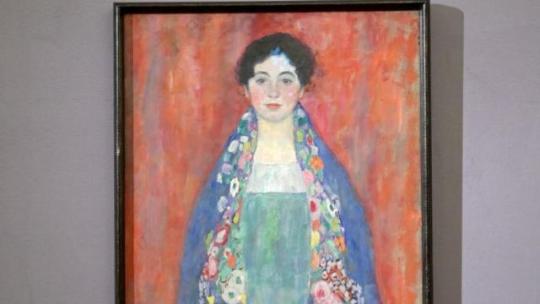
#Gustav Klimt#Gustav Klimt Portrait Found After Vanishing Nearly 100 Years Ago#Gustav Klimt Portrait of Fräulein Lieser#austrian artist#painter#painting#art#artist#art work#art world#art news#history#history news
67 notes
·
View notes
Text

Egon Schiele: Seated Male Nude, Back View (1910)
Watercolor and black crayon, 45 x 24.8 cm
Private collection
(Kallir d653)
37 notes
·
View notes
Text
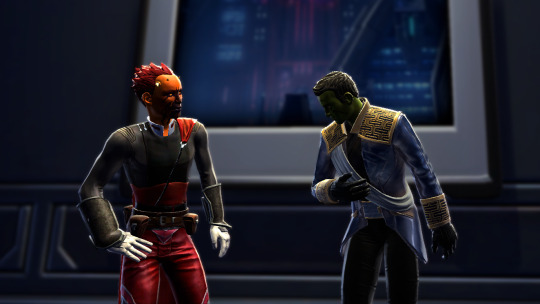




the spy dance (feat. kallir @villainship )
17 notes
·
View notes
Text
More recently, Holger Zellentin informally suggested to me a Talmudic source for Q. 5:64, a passage in BT Menahot 29b. There, R. Judah relates in the name of Rav that when Moses went up to Mount Sinai to get the Torah from God (recorded in Exodus 19-20), he came upon God sitting and painstakingly drawing crowns on the letters of the Bible. Said Moses to God, 'Master of the Universe, who delays Your hand (mi me'akev yadcha)? In other words, Moses wished to know who was preventing God from finishing His transcription of the holy text and sending it down to the Israelites.
God replied that in the future a scholar named 'Aqiba ben Joseph would arise and expound mountains of rabbinic teaching on each crown. Zellentin posited that according to the rabbis God here holds Himself back, restrains His own hand, in order 'to leave the interpretation of the Torah to the Rabbis'. Indeed, rabbinic teaching, here and elsewhere, celebrates the rabbinic enterprise of Torah explication as a sort of rabbinic-God partnership that is Divinely ordained. Zellentin, however, suggests that Q. 5:64 flips this rabbinic teaching on its head, using the Talmud's own language to reject its claims. Unlike the rabbis, the Qur'an maintains that God does not restrain Himself in order to allow human participation in His revelation; what's more, for the Qur'an the claim that He does so borders on sacrilege.
[…] Zellentin's proposal takes into account the often polemical nature of the Qur'an's use of the texts of earlier monotheist traditions against them[.]
Shari L. Lowin (The Jews Say the Hand of God is Chained: Q. 5:64 as a Response to a Midrash in a piyyut by R. El'azar ha-Kallir). Italics original.
If the title of her article doesn't make it clear, Lowin does not think this interpretation is correct; I still found it interesting.
2 notes
·
View notes
Text

Egon Schiele:
House with Bell Tower (1912)
Watercolor and pencil
size: 48.2 x 32 cm
Private collection
(Kallir D1203)
Accordingto Jane Kallir the location could be a place called the Semmering 65 miles from Vienna. Schiele may have passed the area in may 1912.
#art detail#aesthetic art#electronic arts#aesthetic#egon schiele#art#painting#traditional painting#graphic art#house with bell tower
29 notes
·
View notes
Text

Egon Schiele: Two Women Embracing (1911)
Watercolor and pencil, 56 x 37 cm
University Art Museum, University of California, Berkeley
(Kallir D885)
7 notes
·
View notes
Text
Grandma Moses: Acclaimed Self-Taught ‘Primitive’ Artist Who Started Painting In Her Late Seventies
Grandma Moses: A journey shows that age is not a bar for learning. In her late seventies, she decided to take up painting which was easier on her hands, as compared to needlework. She made her first painting using house paint. Her work was later displayed in museums and gained appreciation and fame from well-known artists.
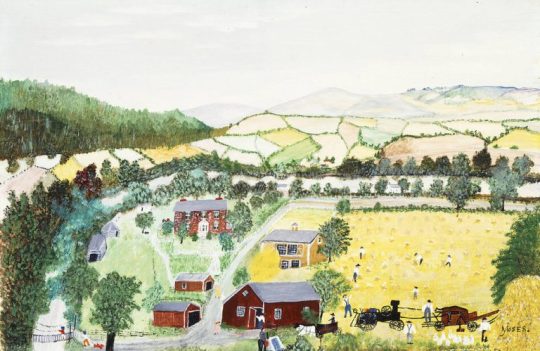
On this day, 7th of September, 1860, Anna Mary Robertson Moses was born in Greenwich, New York, US. She was the third of ten children born to Russell King Robertson, a farmer, and Margaret Shannahan. Due to the lack of warm clothes, Anna Moses attended school only in the summer. At the age of 12 she left home to work as a hired farm girl. At the age of 26, while working for James Family she met Thomas Moses in 1886. The two fell in love and got married the next year. The couple moved to Virginia where they rented farms and worked the land. Anna gave birth to ten children but five of them died as babies. After some years Thomas became homesick, so he asked his wife to move back towards the north. Eventually they returned to New York and bought a farm there. By this time, Anna was called Mother Moses. She was skilled at various tasks and enjoyed doing needlework such as sewing and embroidering. With needle and thread she would make pictures on fabric, but she had developed arthritis, which made it painful for her to push the needle with through the fabric. In her late seventies, she decided to take up painting which was easier on her hands, as compared to needlework. She made her first painting using house paint.
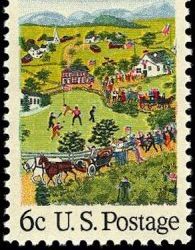
Due to the artist being self-taught her paintings display a lack of nuanced application of Western painting conventions. For this reason, she is categorized as a ‘primitive’ or ‘naïve’ painter under art scholarship, terms synonymous with ‘outsider artist’. Moses’s journey shows that age is not a bar for learning, and that if you’re truly passionate about something, you can reap the rewards of your efforts at any age. Many of Moses’s paintings drew directly from her own life — mainly scenes from the landscape around her. In 1938, her paintings were displayed at a local drug store where an art collector Louis J. Caldor saw them and bought them all for a few dollars each. He inquired about the painter, contacted Moses and bought ten more paintings directly from her. He then arranged to have three of them shown at the New York Museum of Modern Art at an exhibition titled ‘Contemporary Unknown American Painters’, where they attracted wide public attention, leading to her fame. The works were also spotted by the Austrian-American art historian Otto Kallir at the exhibition, and he was highly appreciative of their inherent folk quality. Pleased with her work, Otto curated first solo show titled, ‘What A Farm Wife Painted’ in 1940 at the Galerie St. Etienne in New York. It was at this show that a reporter gave her the nickname, ‘Grandma Moses’.

The New York Times said of her the following: “The simple realism, nostalgic atmosphere and luminous color with which Grandma Moses portrayed simple farm life and rural countryside won her a wide following. She was able to capture the excitement of winter’s first snow, Thanksgiving preparations and the new, young green of oncoming spring… In person, Grandma Moses charmed wherever she went. A tiny, lively woman with mischievous gray eyes and a quick wit, she could be sharp-tongued with a sycophant and stern with an errant grandchild.”
Most of the artist’s paintings depicted scenes from upstate New York and Vermont. Several paintings show a particular ’checkered house’. She painted many scenes depicting farm life. Her paintings told stories about making apple butter, making soap and maple syrup, husking corn, and making candles. ‘The Quilting Bee’ shows how women would meet and visit while they made quilts.
Grandma Moses was awarded two honorary doctoral degrees. The first was bestowed in 1949 by Russell Sage College and the second, two years later by the Moore College of Art and Design. She passed away on December 13, 1961, in a medical center in Hoosick Falls, New York. Her works are included in the collections of the Art Institute of Chicago, the Phillips Collection in Washington, D.C., the Metropolitan Museum of Art in New York, and the Bennington Museum in Vermont. Her work ‘Sugaring Off’ sold at Christie’s New York ‘Important American Paintings’ in 2006 for $1,360,000.
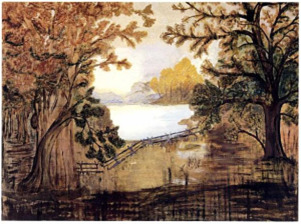
In her autobiographical book Grandma Moses: My Life’s History (1951), the artist testified to the incredible strength and determination to fulfill her own life. She said, “I have written my life in small sketches, a little today, a little yesterday, as I have thought of it, as I remember all the things from childhood on through the years, good ones, and unpleasant ones, that is how they come out and that is how we have to take them. I look back on my life like a good day’s work, it was done and I am satisfied with it. I was happy and content, I knew nothing better and made the best out of what life offered. And life is what we make it, always has been, always will be.”
So, if you think you are too old to pursue your dreams, think of Grandma Moses, and know in your heart it may not be too late for you.
2 notes
·
View notes
Text
Artist Research: Egon Schiele
though not a contemporary artist, Schiele used gesture within his self-portraits o express his identity. In his earlier years as an artist, Schiele considered the human face as the most important feature of an individuals identity.
After working alongside Klimt, Schiele began removing any identity from the backgrounds of his works, solely focusing on the gesture. His self-portraits explore a range of personas and emotions which is hat makes his works relevant. The exploration of identity through the use of gesture shows how he was able to understand his own emotion and how to portray them. I wish to demonstrate this ability through my contemporary take on self portraits.
0 notes
Text
Gustav Klimt Portrait Found After Vanishing Nearly 100 Years Ago
It is One of the Last Works the Artist Painted Before his Death in 1918.
— By Jon Haworth | Published: January 26, 2024
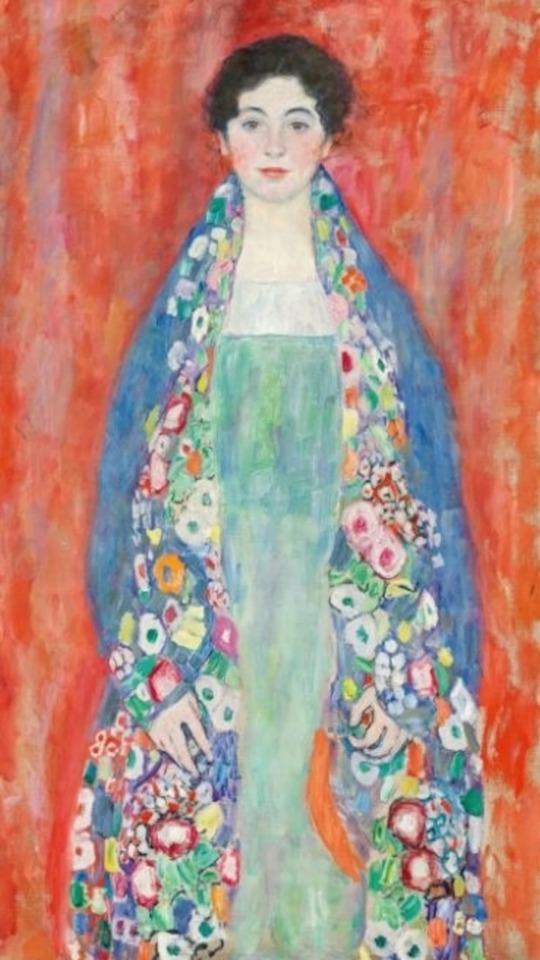
Gustav Klimt's Portrait of Fräulein Lieser. im Kinsky Auction House
LONDON — One of the last paintings by the renowned Austrian artist Gustav Klimt has miraculously been found after vanishing nearly 100 years ago.
The painting, titled Portrait of Fräulein Lieser, was found in Vienna after last being seen by the public in 1925. Until now, the only known photograph of the painting had been held in the archives of the Austrian National Library. The picture was likely taken in 1925 in connection with the Klimt exhibition by Otto Kallir-Nirenstein in the Neue Galerie, Vienna.
Since then, its location had been a mystery.
"The rediscovery of this portrait, one of the most beautiful of Klimt's last creative period, is a sensation," said the im Kinsky auction house in a statement announcing the discovery. "As a key figure of Viennese Art Nouveau, Gustav Klimt epitomizes fin de siècle Austrian Modernism more than any other artist. His work, particularly his portraits of successful women from the upper middle class at the turn of the century, enjoy the highest recognition worldwide."
The work of art will go up for auction at the im Kinsky auction house in Vienna on April 24 and is expected to fetch millions on the market.

A cameraman takes footage of the painting Bildnis Fraeulein Lieser (Portrait of Miss Lieser) by Austrian artist Gustav Klimt (1862-1918) during a press conference of the Kinsky Art Auction House in Vienna, on Jan. 25, 2024. Roland Schlager/APA/AFP via Getty Images
"Klimt's paintings rank in the top echelons of the international art market. His portraits of women are seldom offered at auctions. A painting of such rarity, artistic significance, and value has not been available on the art market in Central Europe for decades," im Kinsky auction house said. "This also applies to Austria, where no work of art of even approximate importance has been available."
The painting will now travel worldwide on short exhibitions until it is auctioned and is set to be presented at various locations internationally, including stops in Switzerland, Germany, Great Britain and Hong Kong.
The model for the painting is labeled as Fräulein Lieser, also known as Margarethe Constance Lieser (1899-1965), daughter of the Austrian industrial magnate Adolf Lieser. But new research by the im Kinsky auction house into the history and provenance of the masterpiece has opened up the possibility that Klimt's model could have been another member of the Lieser family -- either Helene Lieser (1898-1962), the first-born of Henriette Amalie Lieser-Landau and Justus Lieser, or their younger daughter, Annie Lieser (1901-1972), according to officials.

"In April and May 1917, the sitter visited Klimt's studio in Hietzing nine times to pose for him," im Kinsky said. "Klimt probably began the painting in May 1917. The painter chose a three-quarter portrait for his depiction and shows the young woman in a strictly frontal pose, close to the foreground, against a red, undefined background. A cape richly decorated with flowers is draped around her shoulders."
The portrait is thought to be one of Klimt's last paintings and was done shortly before he died of a stroke on Feb. 6, 1918. The painting was left, with several small portions of it unfinished, in his studio and it is thought that the painting was given to the family who had commissioned it after his death.
The painting, however, would soon vanish and the exact fate of the painting after 1925 is unclear.
"What is known is that it was acquired by a legal predecessor of the consignor in the 1960s and went to the current owner through three successive inheritances," im Kinsky auction house said.
0 notes
Text

That 5'2" agent starts to look different from the perspective of being knocked flat. . .
11 notes
·
View notes
Text
Dipinto di donna di Klimt ritrovato a Vienna dopo 100 anni
A Vienna è stato ritrovato un dipinto dell’artista austriaco Gustav Klimt, ritenuto perduto da circa 100 anni. Lo riferisce la BBC. Il ritratto di Fraulein Lieser apparteneva una volta ad una famiglia ebrea in Austria e fu visto in pubblico l’ultima volta nel 1925 in vista di una mostra realizzata nel 1926 da Otto Kallir-Nirenstein nella Neue Galerie di Vienna. Il suo destino non è…
View On WordPress
0 notes
Text
Only the good die young
contemporaneous letterforms fuse
contemporaneous uni
contemporaneous poems
contemporaneous point
contemporaneous Kallir
contemporaneous artbrut
contemporaneous typography
contemporaneous distinct
contemporaneous poetry
contemporaneous Jenny Holzer
contemporaneous occludes the image
contemporaneous G
contemporaneous ads
contemporaneous Wordscapes
contemporaneous trace markmaking of petroglyphs
contemporaneous Thacker
contemporaneous P. Eds
contemporaneous Digital Poetics
0 notes
Text
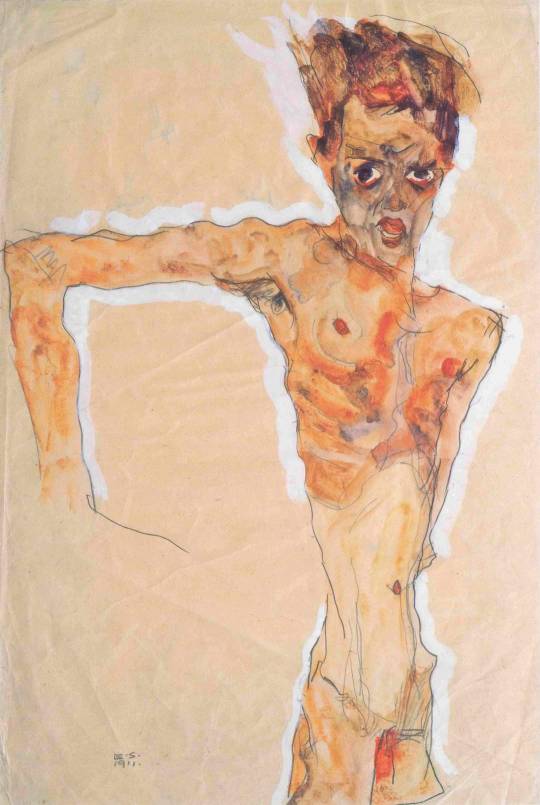
Egon Schiele: Self-Portrait (1911) gouache, watercolor and pencil 51.5 x 35 cm
The MET, New York, USA
(Kallir d953)
6 notes
·
View notes
Photo

The Life & Art of Gustav Klimt: A Short Art History Lesson on the Austrian Symbolist Painter and His Work
The Austrian symbolist painter, Gustav Klimt, a driving force of the Vienna Secession, has joined the ranks of famous, dead artists being served up as pricey, super-sized, Instagram-friendly immersive experiences. Jane Kallir, author of Gustav Klimt: 25 Masterworks and co-founder of the Kallir Research Institute, a foundation dedicated to furthering the study of Austrian and […]
https://www.openculture.com/2023/02/the-life-art-of-gustav-klimt.html
0 notes